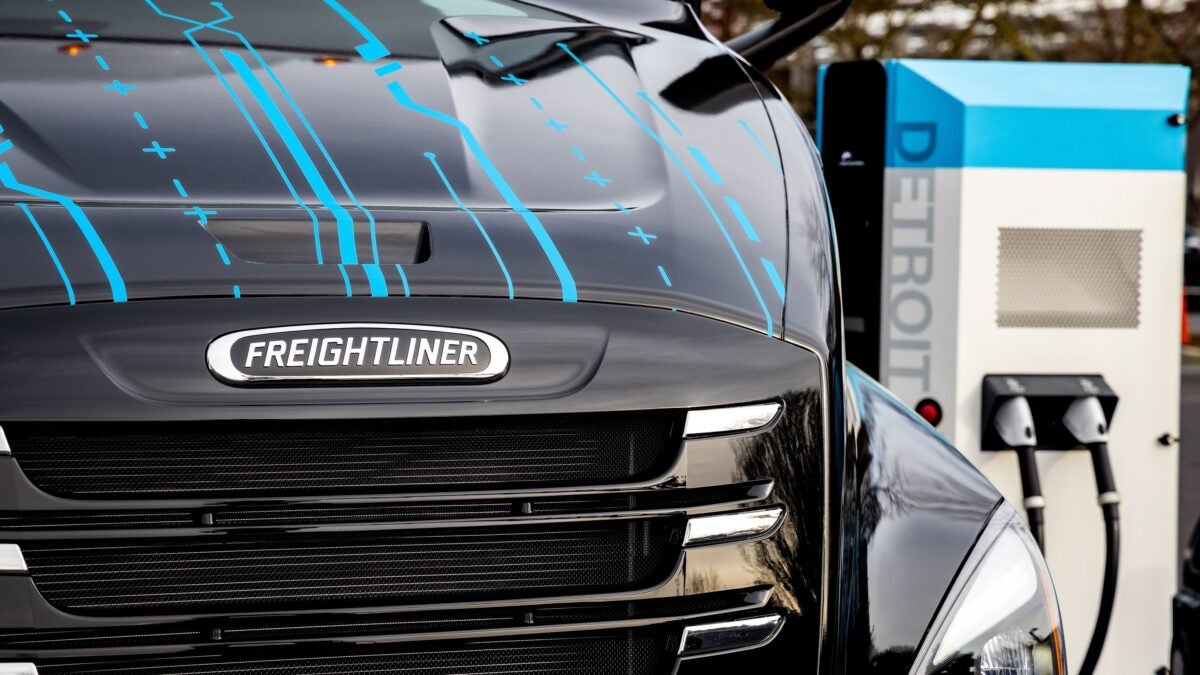LONG BEACH, Calif. — After more than a million miles of real-world customer tests, Daimler Truck North America has revealed the production version of the battery-powered Class 8 Freightliner eCascadia.
At an Advanced Clean Transportation Expo briefing late Monday, a second-gen eCascadia drove a few feet from behind a black screen to the center of DTNA’s display. It joined an MT50e walk-in van built on a Freightliner Custom Chassis Corp. frame. An eM2 Class 6 straight truck, and a Thomas Built Jouley electric school bus plus Detroit eFill chargers covered the small stage..

Based on the market-leading Cascadia, Daimler built and shared a test fleet of 30 electric versions for concentrated drayage. NFI Industries went back and forth from Chino, California, to the ports of Los Angeles and Long Beach. Penske Truck Leasing delivered packages in Southern California.
A 10-truck customer experience fleet provided one-off trials with nearly 50 fleets nationwide. They included Schneider, J.B. Hunt Transport and Bison Transport.
700 eCascadia orders in backlog
“This was not really testing for the customer. This was testing with the customer,” said Rakesh Aneja, DTNA head of eMobility. “Our customers were testing the products unlike anything we have ever done before.”
Production of two runs of pre-series eCascadia begins in Portland, Oregon, later this year. Daimler has more than 700 orders, most of which will be built and delivered in 2023. Daimler will add its eM2 Class 6 medium-duty electric truck to its lineup a year from now.
Some of the second-generation trucks, with typical single-charge range of 230 miles, will replace first-gen models that could travel about 150 miles before needing to be plugged in. Some of the dedicated experience fleet operated by NFI and Penske accumulated 50,000 to 100,000 miles each, Aneja said.
eCascadia features
The eCascadia is more than just a zero tailpipe-emissions truck. Nifty safety features, hand-holding to prepare fleet customers for driving electric and branded charging stations announced over the last year form an ecosystem.
The second-gen truck offers three battery sizes with charging times of as little as 90 minutes for 194 kilowatt hours to up to six hours for a 483kW powertrain. Two electronic axle designs are available. With a dual motor, maximum torque is 23,000 pound feet generating 395 maximum horsepower. A single motor creates max torque of 11,500 pound feet and max 195 horsepower.
Developments from Daimler’s Detroit technology subsidiary coming in Q4 abound in the eCascadia. A charger management system will track how the truck complies for purchase grants received — electric trucks cost two to three times as much as diesel-powered models — and Low Carbon Fuel Standard credits.
The management system also will automatically display the driving range over the course of a proposed trip. It analyzes analyzes load, weather, traffic and road gradient. A post-trip analysis will make suggestions for how to improve performance next time. Over-the-air remote software updates carry over from the Cascadia.
Consulting services come in Baseline, Powerline and Megaline packages. They cover everything from setting up behind-the-fence charging to chasing down rebates and selecting sites.
No right turn
Freightliner carried over advanced driver safety systems from its conventional Cascadia, including Detroit Assurance Active Brake Assist. The eCascadia features Active Side Guard Assist, which activates when the truck is moving less than 12 miles an hour to prevent a right turn when a pedestrian or motorist is detected on the passenger side of the truck.
Other safety features include active lane assist to keep the truck centered and active steer assist that helps reduce effort in tight turning situations. At highway speeds, it senses and holds steering on steep crowned roads and during heavy crosswinds. In case of a tire blowout, active steering keeps the steering centered while the vehicle is pulled to the side of the road.
An electric fait accompli
The move to zero-emissions vehicles is a fait accompli, DTNA CEO John O’Leary said.
“The future is going to be zero-emissions vehicles. Whether I like it or some driver in Moline, Illinois, or you like [it] doesn’t matter,” O’Leary said. “The regulators have decreed that it will be so, and so we need to get on board with that.”
The Daimler Truck corporate goal of carbon neutrality in its key markets by 2039 is “not a light switch moment,” he said. “It’s not going to happen next week or next year or five years from now. But that’s the direction that things will be moving.”
UPS encouraged Daimler to go electric.
“I feel good about this Freightliner project because when Roger Nielsen was the CEO, I was pushing him for electric tractors,” said Carlton Rose, UPS president of global fleet maintenance and engineering. “This is just an evolution of our first talks.”
O’Leary said customer demand for environment, sustainability and governance was hardly mentioned two years ago.
“So things are changing,” he said. “We have to adapt. The dumbest thing we could do is just sit and do what we’ve always done and expect to remain on top.”
Related articles:
Daimler’s electric trucks cross 1 million real-world miles
Daimler Truck, BlackRock and NextEra Energy’s $650M bet on electric infrastructure
